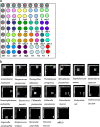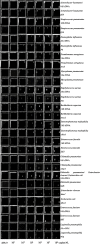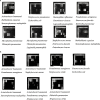Development of a DNA microarray assay for rapid detection of fifteen bacterial pathogens in pneumonia
- PMID: 32576241
- PMCID: PMC7310556
- DOI: 10.1186/s12866-020-01842-3
Development of a DNA microarray assay for rapid detection of fifteen bacterial pathogens in pneumonia
Abstract
Background: The rapid identification of pathogenic bacteria is important for determining an appropriate antimicrobial therapy for pneumonia, but traditional bacterial culture is time-consuming and labourious. The aim of this study was to develop and evaluate a DNA microarray assay for the simultaneous detection of fifteen bacterial species directly from respiratory tract specimens in patients with pneumonia. These species included Streptococcus pneumoniae, Staphylococcus aureus, Haemophilus influenzae, Escherichia coli, Klebsiella pneumoniae, Pseudomonas aeruginosa, Acinetobacter baumannii, Mycoplasma pneumoniae, Enterococcus faecalis, Enterococcus faecium, Enterobacter cloacae, Stenotrophomonas maltophilia, Burkholderia cepacia, Legionella pneumophila and Chlamydia pneumoniae. The 16S rDNA genes and other specific genes of each pathogen were chosen as the amplification targets, amplified via multiplex polymerase chain reaction (PCR), and hybridized to oligonucleotide probes in a microarray.
Results: The DNA microarray detection limit was 103 copies/μL. Nineteen standard strains and 119 clinical isolates were correctly detected with our microarray, and 3 nontarget species from 4 clinical isolates were not detected. Additionally, bacterial pathogens were accurately identified when two or three bacterial targets were mixed together. Furthermore, the results for 99.4% (156/157) of clinical specimens were the same as those from a conventional assay.
Conclusions: We developed a DNA microarray that could simultaneously detect various bacterial pathogens in pneumonia. The method described here has the potential to provide considerable labour and time savings due to its ability to screen for 15 bacterial pathogens simultaneously.
Keywords: Bacteria; DNA microarray; Pneumonia.
Conflict of interest statement
The authors declare that they have no competing interests.
Figures



Similar articles
-
Methodology and application of multiplex PCR-dipstick DNA chromatography for the detection of eight respiratory bacterial pathogens.Front Cell Infect Microbiol. 2025 May 27;15:1558612. doi: 10.3389/fcimb.2025.1558612. eCollection 2025. Front Cell Infect Microbiol. 2025. PMID: 40496013 Free PMC article.
-
Simultaneous Detection of 13 Key Bacterial Respiratory Pathogens by Combination of Multiplex PCR and Capillary Electrophoresis.Biomed Environ Sci. 2017 Aug;30(8):549-561. doi: 10.3967/bes2017.074. Biomed Environ Sci. 2017. PMID: 28807095
-
Detection of respiratory bacterial pathogens causing atypical pneumonia by multiplex Lightmix® RT-PCR.Int J Med Microbiol. 2018 Apr;308(3):317-323. doi: 10.1016/j.ijmm.2018.01.010. Epub 2018 Jan 31. Int J Med Microbiol. 2018. PMID: 29397298
-
Characterization of microbial pathogens by DNA microarrays.Infect Genet Evol. 2009 Sep;9(5):987-95. doi: 10.1016/j.meegid.2008.10.016. Epub 2008 Nov 17. Infect Genet Evol. 2009. PMID: 19061975 Free PMC article. Review. No abstract available.
-
Emergent Pneumonia in Children.Front Pediatr. 2021 Jun 17;9:676296. doi: 10.3389/fped.2021.676296. eCollection 2021. Front Pediatr. 2021. PMID: 34222146 Free PMC article. Review.
Cited by
-
Recent Advances in Nanotechnology for the Management of Klebsiella pneumoniae-Related Infections.Biosensors (Basel). 2022 Dec 10;12(12):1155. doi: 10.3390/bios12121155. Biosensors (Basel). 2022. PMID: 36551122 Free PMC article. Review.
-
Critical Issues on the Surface Functionalization of Plasmonic Au-Ag/TiO2 Thin Films with Thiolated Oligonucleotide-Based Biorecognition Elements.Biosensors (Basel). 2024 Mar 27;14(4):159. doi: 10.3390/bios14040159. Biosensors (Basel). 2024. PMID: 38667152 Free PMC article.
-
Development of machine learning-based differential diagnosis model and risk prediction model of organ damage for severe Mycoplasma pneumoniae pneumonia in children.Sci Rep. 2025 Mar 19;15(1):9431. doi: 10.1038/s41598-025-92089-3. Sci Rep. 2025. PMID: 40108182 Free PMC article.
-
Laboratory tools for the direct detection of bacterial respiratory infections and antimicrobial resistance: a scoping review.J Vet Diagn Invest. 2024 May;36(3):400-417. doi: 10.1177/10406387241235968. Epub 2024 Mar 8. J Vet Diagn Invest. 2024. PMID: 38456288 Free PMC article.
-
Nanoplasmonic microarray-based solid-phase amplification for highly sensitive and multiplexed molecular diagnostics: application for detecting SARS-CoV-2.Mikrochim Acta. 2024 Oct 29;191(11):715. doi: 10.1007/s00604-024-06723-4. Mikrochim Acta. 2024. PMID: 39472332 Free PMC article.
References
-
- Eccles S, Pincus C, Higgins B, Woodhead M; Guideline Development Group Diagnosis and management of community and hospital acquired pneumonia in adults: summary of NICE guidance BMJ 2014, 349: g6722. https://doi.org/10.1136/bmj.g6722. - PubMed
-
- Reddington K, Tuite N, Barry T, O'Grady J, Zumla A. Advances in multiparametric molecular diagnostics technologies for respiratory tract infections. Curr Opin Pulm Med 2013;19(3):298–304. https://doi.org/10.1097/MCP.0b013e32835f1b32. - PubMed
-
- Harris M, Clark J, Coote N, Fletcher P, Harnden A, McKean M, et al. British Thoracic Society guidelines for the management of community acquired pneumonia in children: update 2011. Thorax. 2011;66(Suppl 2):ii1-ii23. http://dx.doi.org/10.1136/thoraxjnl-2011-200598. - PubMed
-
- Song KP, Chan TK, Ji ZL, Wong SW. Rapid identification of Pseudomonas aeruginosa form ocular isolates by PCR using exotoxin A-specific parimers. Mol Cell Probes 2000;14(4):199–204. http://dx.doi.org/10.1006/mcpr.2000.0306. - PubMed
-
- Ginevra C, Barranger C, Ros A, Mory O, Stephan JL, Freymuth F, et al. Development and evaluation of Chlamylege, a new commercial test allowing simultaneous detection and identification of Legionella, Chlamydophila pneumoniae, and mycoplasma pneumoniae in clinical respiratory specimens by multiplex PCR. J Clin Microbiol 2005;43(7):3247–3254. http://dx.doi.org/10.1128/jcm.43.7.3247-3254.2005. - PMC - PubMed
MeSH terms
Substances
LinkOut - more resources
Full Text Sources
Medical

